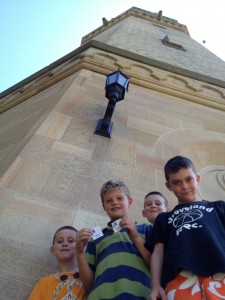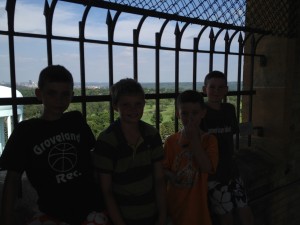This Saturday and Sunday, Oct. 11-12, the Highland Water Tower in St Paul will be open, 9 a.m. to 5 p.m. each day. If you can climb 151 steps while carrying your kids or helping your old ones, you owe it to yourself and them to give it a go. Here’s why:
The other day, I overheard a little boy telling his father that they lived in a forest. The dad, who owns a home on a city lot, tried to figure out what the kid was talking about, so he asked the boy if he had seen something on Sesame Street about animals who live in the woods.
“No,” he said. “We live in a forest. I saw it. You did, too.”
The dad’s face lit up as he realized what his son meant.
“Oh, the water tower ,” he said. “Yes, from the water tower , it looks like we live in a forest!”
That dad and his son were among the estimated 2,500 people who climbed to the top of the Highland Park Water Tower in St. Paul last weekend, when it was open to the public during Highland Fest. I was among the hard-breathing crowd, shepherding one of my brothers and his family up the 151 steps to the observation level so they could see their new home from above (they just moved back to Minnesota from Texas).
And as any one of those 2,500 can tell you, the boy was right:
We do live in a forest.
And, as in any forest, we live in a fragile ecosystem of interrelations and interdependence. If something happens in one part of the forest, it has an effect on everything and everyone at the other edge of the forest.
This will seem to some like a world view based on “Bambi,” and will be open to ridicule by the bigfoots who deny there is any connection between their lives and the lives of the other creatures in the forest. If you want to see how their theories play out, go to a legislative hearing sometime and watch how legislators from different cities act as if they have nothing in common.
But I didn’t get my world view from Disney. I got it from the nuns. And I get it reinforced from the Highland Tower .
It takes a bit of effort to get up to the observation deck, 151 steps of huffing and puffing, especially when you are carrying a kid along with you, which is the best way to do it. But when you reach the top, you can see the Twin Cities the way they are – not as they are drawn on a map, but as they are drawn on the planet, by God and man.
You won’t see any municipal boundaries or be able to detect any artificial distinctions between inner city and outer suburb. You can’t see black or white, native-born or immigrant, Republican or Democrat, bus rider or SUV owner. All you can see is the place where we live together and where we spend too much time arguing and not enough time appreciating.
What you see is the beauty and fragility of the big woods where 3 million people work and live and raise families. And where we seem – lately – to fight more over the things that separate us than we fight for the things that connect us.
Too often, we can’t see the forest for the trees.
From the 127-foot tower , which is atop the highest hill between downtown St. Paul and Minneapolis, what strikes you right away is the awesomely lush urban forest, a fabulous canopy of trees broken here and there by church spires, high-rise buildings and, on the horizons, downtown St. Paul (4 miles away) and downtown Minneapolis (6.5 miles away).
Tower climbing is not just for St. Paulites, by the way. Residents of Minneapolis and the suburbs also will appreciate the view of home from the best vantage point I know of.
I’ve made the tower trek every year for more than a decade, and I recommend it to anyone who wants to know the Twin Cities, or who thinks they already do. If it were up to me, no one would be allowed to run for public office until they had climbed to the top. And if reaching the top didn’t open their eyes, I’d be tempted to show them down, the quick way.
Designed by Minnesota’s first black architect, Clarence Wigington, the handsome tower opened in 1928. One of three Wigington-designed St. Paul buildings on the National Register of Historic Places, the tower is built around a 200,000-gallon water tank that reverberates loudly when visitors pound their fists against it as they climb the winding stairs.
There are many higher buildings around, but few offer opportunities for public viewing and, besides, they are too high. People look like ants from a 50-story high-rise. But the Highland Tower is human in scale and humanizing in effect: It changes how you see this place.
Want to understand why people complain about airport noise? Climb the Highland water tower and you’ll be amazed at how close the sprawling international airport looks (it’s just 3.5 miles to the Lindbergh terminal). You can practically pick up your baggage. But you don’t need to battle freeway gridlock to travel miles with your eyes. From the oil refinery at Pine Bend to the Carlson Towers in Plymouth, the Twin Cities look lovely, uncrowded and surprisingly small.
We look better than we think.
My trip up the steps last weekend felt especially necessary this year. I am weary of the contentiousness in every part of our public life. I longed to see the big picture.
So when I got to the top, I looked for the bell tower on my church, which is one of the only objects poking out from the trees in my neighborhood. Then I looked for the big garrison flag on the round tower at historic Fort Snelling and tried to trace the hollow of the Mississippi River downstream from there, past Mendota, beneath the West Side, on through downtown St. Paul and under the East Side bluffs. What looks so formidable and so impassable up close is just a gentle rill in the green carpet from above.
I lingered half an hour. Until I felt refreshed. Until my vision was restored. Until I recognized the lay of my land.



Thanks Nick. I love your take on things. I’ve always said we are fortunate to live here…leafy streets, a river running through them and in most cases we can get to a place that feels very far removed from the city within 15 minutes of our front door.